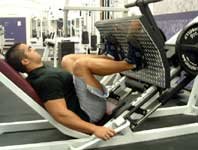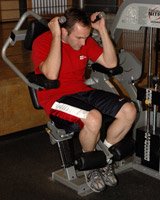 | People need to believe that existing training regimens really do work and that life does not have to be that complicated. Today I will share with you the tried and true 5x5 program. Yes it does work. |

By: Mike Mahler
Over the years training has become more and more complicated. Show the average modern day trainee a simple and effective training regimen and they will look at you like you are dumb enough to buy a time-share. They just cannot believe that simple training programs work.
They want to believe that training is a complicated progress so that they can spend more time planning workouts than doing workouts. This is not surprising, as many people tend to complicate everything in life these days. So it is not surprising that the masses feel that complicated training regimens are a necessity.
 The bottom line is that standard training regimens that have been tried and tested over the years are hard to beat. One such program is the well-known 5x5 (five sets of five) program.
The bottom line is that standard training regimens that have been tried and tested over the years are hard to beat. One such program is the well-known 5x5 (five sets of five) program.
It was the favorite of Reg Park who just so happens to be one of Arnold's idols for a very simple reason. The program rocks and when applied correctly builds a tremendous amount of size and strength.
With all of the thousands of training regimens to choose from the 5x5 program remains as one of the most effective programs for packing on size and strength. It has just the right amount of intensity and volume to build strength and size without inducing burnout and over-training.
In this article, I am going to go over what the 5x5 program is and how to apply it. Then, I am going to go over several ways to take the intensity up a notch for further gains in size and strength.
If you are tired of complicating programs that take more time to plan than execute, then you are going to love the 5x5 protocol. Let's get started.

What Is 5x5? 
The 5x5 program calls for doing five sets of five reps per exercise. To illustrate, lets use the barbell deadlift as an example. Do two warm-up sets to get the groove down. Then load the bar up to your working weight and do five sets. When you can do five reps on all five sets, increase the weight by five pounds.


Barbell Deadlift.
For a focus on strength, take three-minute breaks in between each set. For a focus on size, try ninety-second breaks in between each set. Finally, for the middle path, try two-minute breaks in between each set. To design a 5x5 program you can either do a split routine in which you do the upper body one day and lower body the next training session.
Or you can do a full body workout 2-3 times per week. It will take some experimenting to determine which option is best for you. Regardless, of which option your choose, focus on compound exercises for each workout such as bench presses, squats, deadlifts, weighted dips, barbell rows, etc. Some isolation work is acceptable, but do not get carried away.
Focus on exercises that give you the most bang for your buck. Now you could do the same exercises frequently such as bench presses three times a week 5x5 style. Or you could try Louie Simmons conjugate approach to switch things up.

Louie Simmons, One Of Only 6 Lifters To Total Elite In 5 Weight Classes.
For example, do bench presses on Monday, weighted dips on Wednesday, and incline presses on Friday. You will avoid overuse injuries and the exercises are similar enough that you will make progress on all three and build overall strength. Here are two sample 5x5 programs:
 Option One (Full Body Routine)
Option One (Full Body Routine)
- Monday
A-1: barbell bench press
A-2: bent over row
B-1: barbell squat
B-2: stiff legged deadlift
Turkish Get-up 2x5 l,r (left and right)
Wednesday
A-1: weighted dips
A-2: weighted chin-ups
Barbell deadlift
Hanging leg raise 2x5
Friday
A-1: incline press
A-2: renegade row
B-1: front squat
B-2: glute/ham raise
Saxon side bend 2x5


Renegade Row
Do each pair back to back. For example, do one set of A-1, wait ninety seconds, and then do a set of A-2 and wait ninety seconds before going back to A-1. Keep going back and forth until you have completed all of the sets and reps. For the midsection work, take two minute breaks in between each set.
 Option Two: Split Routine
Option Two: Split Routine
- Monday & Thursday
A-1: barbell bench press
A-2: bent over row
B-1: barbell curl 2x5
B-2: skull crusher or triceps pushdown 2x5
Tuesday And Friday
B-1: barbell squat
B-2: glute/ham raise
Seated calf raise 2x5
Turkish Get-up 2x5 l,r (left and right)
Do each pair back to back. For example, do one set of A-1, wait ninety seconds, and then do a set of A-2 and wait ninety seconds before going back to A-1. Keep going back and forth until you have completed all of the sets and reps. For the midsection work, take two minute breaks in between each set and for the arm work take one-minute breaks in between each set.

Variations Of 5x5 For Accelerated Increases In Size & Strength 
Now once you have gone through a few cycles of a standard 5x5 regimen, there are several things to manipulate to intensify the program and to fine-tune it for various goals.
 Different Exercise Breaks At Each Session
Different Exercise Breaks At Each Session
- Lets say that strength and size is your goal. One thing that you could do is apply variations to the exercise breaks. For example, one day take one-minute breaks to focus on hypertrophy. At the next session, take two-minute breaks to focus on strength.
The breaks would be applied to antagonistic sets. Thus, you are essential getting two-minute breaks on the first option and four minute breaks on the second option. Here is an example of such a program:
Monday (Two Minute Breaks In Between Each Set)
A-1: bottom position barbell bench press
A-2: dumbell row
B-1: barbell squat
B-2: glute/ham raise
Turkish Get-up 2x5 l,r (left and right)
Wednesday (One-Minute Break In Between Each Set)
A-1: weighted dips
A-2: weighted chin-ups
Barbell deadlift
Hanging leg raise 2x5
Friday (Thirty Second Breaks In Between Each Set)
A-1: floor press
A-2: renegade row
B-1: front squat
B-2: glute/ham raise
 Decrease The Exercise Breaks To Increase The Intensity
Decrease The Exercise Breaks To Increase The Intensity
- Another option is to change the breaks at each session as a way to increase the intensity. For example, do five sets of five on barbell squats with 315 with three-minute breaks. Instead of increasing the weight at the next session, decrease the breaks to two-minutes and thirty seconds.
Once you can complete five sets again, go down to two-minute breaks. Once you nail five sets again, go down to ninety seconds. When you get down to one-minute breaks, increase the weight by five pounds and start at three-minute breaks again.
Using this format, you start with a strength focus on gradually shift gears to a hypertrophy focus as the exercise breaks decrease. Then you shift gears once again back to a strength focus.
This is a great way to cycle training intensity and keep training fresh and challenging.

5x5 On Steroids: Enter Cluster Training
No I am not talking about using steroids on the five times five program. However applying a concept called cluster training to the 5x5 regimen is like adding rocket fuel to a car. I learned about cluster training in Charles Poliquins excellent book Modern Trends In Strength Training.
Cluster training is essentially a combination of rest pause training and standard training.
Here is how it works. Take 90% of your one-rep max and do one rep. Wait ten seconds, and do another rep. Keep going until you have completed five reps in rest pause fashion.
Once you have completed all five reps, take a three-minute break and then execute another cluster set. Each sequence of repetitions equals one set. Thus to apply this concept to the 5x5 protocol, you would do five sets of five rest pause sets.
 What Is The Advantage Of Applying Cluster Training?
What Is The Advantage Of Applying Cluster Training?
- For one, you get to train at a significantly higher training intensity. Thus, if strength is your primary goal, you will love cluster training. Regardless, the volume is the same as a regular 5x5 program making the 5x5 cluster training program an excellent option for hypertrophy training as well.
To further induce hypertrophy, just decrease the breaks in between each cluster. For example, instead of taking three-minute breaks, take two-minute breaks in between each cluster. As effective as cluster training is, it takes some time to break into it. If you have never done rest pause training before, then check out the rest pause article that I wrote for t-nation.com a few years ago and start with the program in the article.
Once you are comfortable with both 5x5 and rest pause training, try marrying the two and apply cluster training 5x5 style. Now cluster training is very intense and three full body workouts will be too much for most trainees. Try doing two full body workouts per week with at least two days off between each session.
Or split up the upper body and lower body days and try four workouts per week. Upper body on day one, take a day off, and then lower body on day two. Take another day off and do the upper body workout again etc.
Also, I would recommend that you choose exercises for Cluster training that do not require a lot of set-up time.
 | ||
| For Example, Bottom position bench presses are better than regular bench presses in which you have to rack the bar after each rep. | ||
Here is a sample Cluster training 5x5 program:
- Day 1 & 3
Bottom position bench press
Weighted pull-up
Barbell curl
Day 2
Bottom position squat
Glute-ham raise (regular 5x5 style)
Calf raise
Turkish get-up 2x5 (regular rep style)
Day 4
Barbell deadlift
One-legged squat
Seated calf raise
Dumbbell windmill 2x5 (regular rep style) Ex. Shown With Kettlebell.
Take three-minute breaks in between each cluster set and two-minute breaks in between each exercise. Stick with cluster training for four to six weeks and then cycle back to a regular 5x5 regimen.

Adapting To High Volume Training:
Start With 5x5 
Finally, you can use the 5x5 protocol as a platform to build up to high volume training. Once you can complete five sets, stay at the same weight and add another set.
Once you can complete six sets, add another set. Keep going until you are doing 10x5. Once you can complete ten sets, increase the weight by five pounds and start back at 5x5.
This is an excellent method for working up to high volume training and cycling high volume training. More importantly, you build confidence for high volume training.
If you have never done ten sets before, then you are not conditioned to handle the volume. By increasing the volume gradually, you prepare your mind and body for the hard work ahead in a systematic manner. You cannot beat that.

Wrap Up
Like many things in life it is much easier to get excited about doing something than it is to get off your ass and do it. What are you prepared to do?
Are you going to test drive the 5x5 program and get bigger and stronger or continue with complicated training regimens that take two hours to complete? Start with a standard 5x5 regimen and then apply some of the intensity enhancers to stay on the road to gainsville. Shoot me an email with your feedback.

 If you don't (or can't) do pull-ups, then you are leaving out one of the best back-building exercises ever. You can't build a championship back without pull-ups - so listen up!
If you don't (or can't) do pull-ups, then you are leaving out one of the best back-building exercises ever. You can't build a championship back without pull-ups - so listen up!













